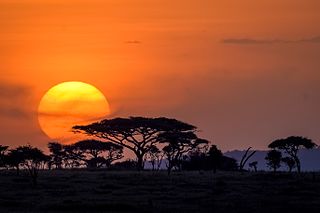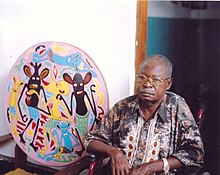
The Maasai are a Nilotic ethnic group inhabiting northern, central and southern Kenya and northern Tanzania. They are among the best-known local populations internationally due to their residence near the many game parks of the African Great Lakes and their distinctive customs and dress. The Maasai speak the Maa language, a member of the Nilotic language family that is related to the Dinka, Kalenjin and Nuer languages. Except for some elders living in rural areas, most Maasai people speak the official languages of Kenya and Tanzania, Swahili and English. The Maasai population has been reported as numbering 1,189,522 in Kenya in the 2019 census, compared to 377,089 in the 1989 census, though many Maasai view the census as government meddling and therefore either refuse to participate or actively provide false information.

The Serengeti ecosystem is a geographical region in Africa, spanning the Mara and Arusha Regions of Tanzania. The protected area within the region includes approximately 30,000 km2 (12,000 sq mi) of land, including the Serengeti National Park and several game reserves. The Serengeti hosts the second largest terrestrial mammal migration in the world, which helps secure it as one of the Seven Natural Wonders of Africa.

Zanzibar is an insular semi-autonomous province which united with Tanganyika in 1964 to form the United Republic of Tanzania. It is an archipelago in the Indian Ocean, 25–50 km (16–31 mi) off the coast of the African mainland, and consists of many small islands and two large ones: Unguja and Pemba Island. The capital is Zanzibar City, located on the island of Unguja. Its historic centre, Stone Town, is a World Heritage Site.
Demonology is the study of demons within religious belief and myth. Depending on context, it can refer to studies within theology, religious doctrine, or occultism. In many faiths, it concerns the study of a hierarchy of demons. Demons may be nonhuman, separable souls, or discarnate spirits which have never inhabited a body. A sharp distinction is often drawn between these two classes, notably by the Melanesians, several African groups, and others. The Islamic jinn, for example, are not reducible to modified human souls. At the same time these classes are frequently conceived as producing identical results, e.g. diseases.

Bies or bes is an evil spirit or demon in Slavic mythology. Under the influence of Christianity the word often became synonymous with chort.
Popobawa, also Popo Bawa, is the name of an evil spirit or shetani, which is believed by residents of Zanzibar to have first appeared on the Tanzanian island of Pemba. In 1995, it was the focus of a major outbreak of mass hysteria or panic which spread from Pemba to Unguja, the main island of the Zanzibar Archipelago, and across to Dar es Salaam and other urban centres on the East African coast.

Following Tanganyika's independence (1961) and unification with Zanzibar (1964), leading to the formation of the state of Tanzania, President Julius Nyerere emphasised a need to construct a national identity for the citizens of the new country. To achieve this, Nyerere provided what has been regarded by some commentators as one of the most successful cases of ethnic repression and identity transformation in Africa.
Duppy is a word of African origin commonly used in various Caribbean Islands, including Barbados and Jamaica, meaning ghost or spirit. The word is sometimes spelled duffy.

George Lilanga was a Tanzanian painter and sculptor, active from the late 1970s and until the early 21st century. He belonged to the Makonde people and lived most of his life in Dar es Salaam, the largest city in Tanzania.
The culture of Mozambique is in large part derived from its history of Bantu, Swahili, and Portuguese rule, and has expanded since independence in 1975. The majority of its inhabitants are black Africans. Its main language is Portuguese. Its median religion is Roman Catholicism, but only about 40% of the inhabitants are Christian. It has a rich history in the areas of arts, cuisine, and entertainment.

Kihaule's mouse shrew is a species of mammal in the family Soricidae endemic to Tanzania where it is known only from the Udzungwa Mountains, at the western end of the Eastern Arc Mountains. Its natural habitats are subtropical or tropical moist montane forests and plantations. It is threatened by habitat destruction and the International Union for Conservation of Nature has assessed its conservation status as being "endangered". It was named after Philip M. Kihaule, a medical-entomological technician, who considerably contributed to the documenting of the small mammals of Tanzania and collected the type specimen of this shrew.

Tourism in Zanzibar includes the tourism industry and its effects on the islands of Unguja and Pemba in Zanzibar a semi-autonomous region in the United Republic of Tanzania. Tourism is the top income generator for the islands, outpacing even the lucrative agricultural export industry and providing roughly 25% of income. The main airport on the island is Zanzibar International Airport, though many tourists fly into Dar es Salaam and take a ferry to the island.

Nungwi, or Ras Nungwi, is a large village located in the far northern end of the island of Zanzibar. With a population of 30,762, Nungwi is the second largest settlement on the island. It is situated in the Nungwi Ward in the Kaskazini A District of the Unguja North Region. It is about 35 miles (56 km) north of Zanzibar Town on the Nungwi Peninsula, about an hour drive from Stone Town. To the south Nungwi shares a border with the neighboring Matemwe- and Tazari villages. Nungwi was traditionally a fishing village and dhow-building center, but is now a popular tourist destination, and for instance recognized in CNN’s list of "100 best beaches of the world" in 2014. West Nungwi has changed a lot since the 1990s and is now a popular tourist destination with numerous resorts, restaurants, bars, stores, etc. East Nungwi is quieter and generally more laid-back.

Makonde chess sets are made by the Makonde tribe of south-west Tanzania and Mozambique who have for centuries been greatly skilled in wood carving and Makonde art is a distinctive style. Chess sets were originally made for export to Europe but the pattern of the pieces follows traditional Makonde designs rather than any established chess pattern.

Malindi Mosque is a mosque in Stone Town, Zanzibar, Tanzania, located near the port. It stems from the 1830s but was possible built on the site of an elder mosque that might have dated back to the 17th century or earlier. Some travel guides claim an origin in the 15th century.
The name Makonde art refers to East African sculptures or, less frequently, to modern paintings created by craftspeople or artists belonging to the Makonde people of northern Mozambique and southern Tanzania, separated by the Ruvuma river. Art historians, dealers and collectors have created this genre of African art, that can be subdivided into African traditional artifacts or modern artistic works. This genre can be traced back to the 1930s, when the first documented exhibition of Makonde art was held at the Centro Cultural dos Novos in Mozambique.

Mazinde is a community in the Korogwe District of the Tanga Region of Tanzania.
The Mueda Plateau, also known as the Maconde Plateau, is a plateau in Cabo Delgado Province of northeastern Mozambique.
Mashetani (Devils) is a play written in 1971 by Tanzanian playwright Ebrahim Hussein. Mashetani was written in Kiswahili and takes place in Tanzania shortly after the political independence. The play centers around the relationship of the characters Juma and Kitaru. The play is four acts. Mashetani has some absurdist elements, including a play within the play and a dream sequence. Hussein also adds descriptions in the stage directions which give the play a more abstract, surreal impression. In Swahili, shetani (singular) is the word for an East African spirit. These spirits are mostly malevolent and appear as distorted figures. The play has been translated to English by Joshua Williams.
Zanzibari independence is a political ambition of some political parties, advocacy groups, and individuals of Zanzibar, a semi-autonomous region territory within Tanzania, to become an independent sovereign state.













